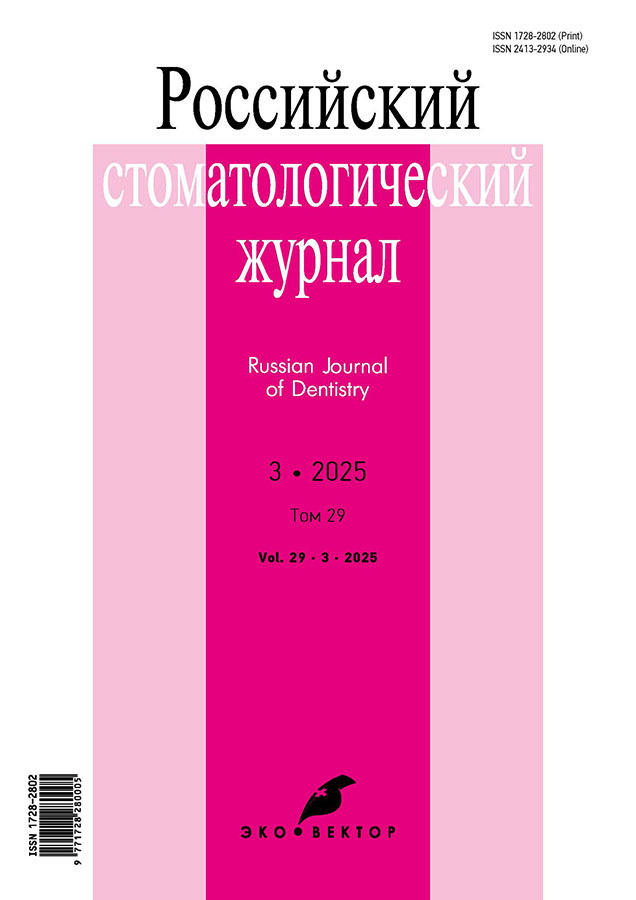Fracture and Crack Probability in Teeth Based on Degree of Structural Loss and Type of Restoration
- 作者: Olesova E.A.1, Nekrasova E.A.1, Glazkova E.V.1, Iarilkina S.P.1, Olesov A.E.1
-
隶属关系:
- Burnasyan Federal Medical Biophysical Center
- 期: 卷 29, 编号 3 (2025)
- 页面: 219-223
- 栏目: Original Study Articles
- ##submission.dateSubmitted##: 15.05.2025
- ##submission.dateAccepted##: 24.05.2025
- ##submission.datePublished##: 27.06.2025
- URL: https://rjdentistry.com/1728-2802/article/view/679686
- DOI: https://doi.org/10.17816/dent679686
- EDN: https://elibrary.ru/ACWFVR
- ID: 679686
如何引用文章
详细
BACKGROUND: The reported frequency of dental fractures and cracks depending on the degree of tooth destruction and type of restoration does not reflect the probability of these complications under specific clinical conditions. Therefore, statistical modeling of tooth fracture and crack probability under various conditions of dental integrity is highly relevant.
AIM: The study aimed to assess the detection rate and probability of fractured and cracked teeth as related to the extent of structural loss and the method for restoration.
METHODS: In 2024, the Clinical Center of Dentistry, Federal Medical and Biological Agency of Russia, conducted an observational study evaluating the frequency and clinical context of fractured and cracked teeth. Annual reports on treatment volume and structure for dental caries, its complications, and hard tissue restorations were also analyzed. Fracture probability was calculated using a formula incorporating the specific condition under which a fracture or crack was identified, the number of such cases, and the number of corresponding restorative procedures performed within the same time frame.
RESULTS: The detection rate of fractured and cracked teeth was 8.9%, predominantly occurring within 5 years after treatment. The calculated five-year complication probability ranged from 7.8% in vital teeth to 32.8% in devitalized teeth. The highest probabilities were associated with unrestored cavity occupying more than half of the occlusal surface (44.5%) and teeth reinforced with metal posts (52.9%).
CONCLUSION: The five-year fracture and crack probability estimates indicate a marked predisposing effect of the following conditions: devitalization; use of the tooth as an abutment for a removable partial denture; an unrestored cavity occupying more than half of the occlusal surface; and intraradicular reinforcement with a metallic post.
全文:
作者简介
Emilia Olesova
Burnasyan Federal Medical Biophysical Center
编辑信件的主要联系方式.
Email: emma.olesova@mail.ru
ORCID iD: 0000-0003-4511-6317
SPIN 代码: 5767-9158
俄罗斯联邦, Moscow
Ekaterina Nekrasova
Burnasyan Federal Medical Biophysical Center
Email: ekaterina233@mail.ru
ORCID iD: 0000-0003-0380-0575
SPIN 代码: 4291-2151
俄罗斯联邦, Moscow
Elena Glazkova
Burnasyan Federal Medical Biophysical Center
Email: pozharskaya_lena@mail.ru
ORCID iD: 0000-0002-9825-4935
SPIN 代码: 5304-9137
MD, Cand. Sci. (Medicine), Associate Professor
俄罗斯联邦, MoscowSvetlana Iarilkina
Burnasyan Federal Medical Biophysical Center
Email: yarilkina@mail.ru
ORCID iD: 0000-0001-6182-3965
SPIN 代码: 8663-0213
MD, Cand. Sci. (Medicine), Associate Professor
俄罗斯联邦, MoscowArtyom Olesov
Burnasyan Federal Medical Biophysical Center
Email: olesov@implantat.ru
Dr. Sci. (Economics), Professor
俄罗斯联邦, Moscow参考
- Semennikov VI, Semennikova NV, Gatalskaya IYu, et al. Crown-radicular fractures of teeth: possibilities of conservative treatment and prospects. The Dental Institute. 2022;(2):38–39. EDN: JMDGYQ
- Makeeva IM, Byakova SF, Adzhieva EK, et al. Detection of vertical root fractures by cone beam CT. Stomatology. 2016;95(6):9–11. doi: 10.17116/stomat20169569-11 EDN: XRONXJ
- Vorobyeva YuB, Zheleznyak VA, Shchennikova MN, Poplauhin TS. Method of tooth restoration and reinforcement with significant destruction of the tooth crown. Russian Journal of Dentistry. 2023;27(4):271–279. doi: 10.17816/dent296333 EDN: RLMVIQ
- Olesova EA, Ilyin AA, Arutyunov SD, et al. Risk factors for the appearance of cracks and fractures of teeth according to a survey of dentists. Russian Journal of Dentistry. 2024;28(6):562–568. doi: 10.17816/dent634360 EDN: HFEBPX
- Makeeva IM, Byakova SF, Adzhieva EK. Vertical root fracture. Etiology. Clinical symptoms. Diagnostics. International Research Journal. 2016;(12-5):104–107. doi: 10.18454/IRJ.2016.54.055 EDN: XQUTYR
- Haupt F, Wiegand A, Kanzow P. Risk factors for and clinical presentations indicative of vertical root fracture in endodontically treated teeth: a systematic review and meta-analysis. J Endod. 2023;49(8):940–952. doi: 10.1016/j.joen.2023.06.004 EDN: PCCQEC
补充文件







